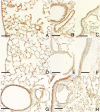Absence of proteinase-activated receptor-1 signaling in mice confers protection from fMLP-induced goblet cell metaplasia
- PMID: 19307611
- PMCID: PMC2784406
- DOI: 10.1165/rcmb.2007-0386OC
Absence of proteinase-activated receptor-1 signaling in mice confers protection from fMLP-induced goblet cell metaplasia
Abstract
The morphological features of chronic obstructive pulmonary disease in man include emphysema and chronic bronchitis associated with mucus hypersecretion. These alterations can be induced in mice by a single intratracheal instillation of N-formyl-L-methionyl-L-leucyl-L-phenylalanine (fMLP), a chemoattractant and degranulating agent for neutrophils. The mechanisms underlying excessive mucus production and, in particular, goblet cell hyperplasia/metaplasia in chronic obstructive pulmonary disease remain poorly understood. The proteinase-activated receptors (PARs) are widely recognized for their modulatory properties during inflammation. In this study, we examined whether PAR-1 contributes to inflammation and lung damage induced by fMLP by comparing the response of PAR-1-deficient (PAR-1(-/-)) mice with that of wild-type (WT) mice. Mice were killed at various time points after fMLP instillation (200 microg/50 microl). WT mice developed emphysema and goblet cell metaplasia. The onset of pulmonary lesions was preceded by an increase in thrombin immunoreactivity in bronchial airways and alveolar tissue. This was followed by a decrease in PAR-1 immunoreactivity, and by an increase in IL-13 immunostaining on the luminal surface of airway epithelial cells. In PAR-1(-/-) mice, fMLP administration induced similar responses in terms of inflammation and emphysema, but these mice were protected from the development of goblet cell metaplasia. The involvement of PAR-1 in airway epithelial cell transdifferentiation was confirmed by demonstrating that intratracheal instillation of the selective PAR-1 agonist (TFLLR) induced goblet cell metaplasia in the airways of WT mice only. These data suggest that emphysema and goblet cell metaplasia occur independently, and that PAR-1 signaling through IL-13 stimulation may play an important role in inducing goblet cell metaplasia.
Figures







Similar articles
-
Pseudomonas aeruginosa pyocyanin causes airway goblet cell hyperplasia and metaplasia and mucus hypersecretion by inactivating the transcriptional factor FoxA2.Cell Microbiol. 2012 Mar;14(3):401-15. doi: 10.1111/j.1462-5822.2011.01727.x. Epub 2011 Dec 28. Cell Microbiol. 2012. PMID: 22103442
-
Human neutrophil elastase-mediated goblet cell metaplasia is attenuated in TACE-deficient mice.Am J Physiol Lung Cell Mol Physiol. 2013 May 15;304(10):L701-7. doi: 10.1152/ajplung.00259.2012. Epub 2013 Apr 5. Am J Physiol Lung Cell Mol Physiol. 2013. PMID: 23564510 Free PMC article.
-
Epithelial miR-141 regulates IL-13-induced airway mucus production.JCI Insight. 2021 Mar 8;6(5):e139019. doi: 10.1172/jci.insight.139019. JCI Insight. 2021. PMID: 33682796 Free PMC article.
-
Cellular and molecular mechanisms of goblet cell metaplasia in the respiratory airways.Exp Lung Res. 2013 May-Jun;39(4-5):207-16. doi: 10.3109/01902148.2013.791733. Epub 2013 May 3. Exp Lung Res. 2013. PMID: 23638644 Review.
-
New pharmacotherapy for airway mucus hypersecretion in asthma and COPD: targeting intracellular signaling pathways.J Aerosol Med Pulm Drug Deliv. 2010 Aug;23(4):219-31. doi: 10.1089/jamp.2009.0802. J Aerosol Med Pulm Drug Deliv. 2010. PMID: 20695774 Review.
Cited by
-
Impact of a functional polymorphism in the PAR-1 gene promoter in COPD and COPD exacerbations.Am J Physiol Lung Cell Mol Physiol. 2014 Aug 15;307(4):L311-6. doi: 10.1152/ajplung.00128.2014. Epub 2014 Jun 27. Am J Physiol Lung Cell Mol Physiol. 2014. PMID: 24973402 Free PMC article.
-
Oral high-dose ankaferd administration effects on gastrointestinal system.Int J Med Sci. 2013;10(4):451-6. doi: 10.7150/ijms.4875. Epub 2013 Mar 2. Int J Med Sci. 2013. PMID: 23471574 Free PMC article.
-
Modulation of protease activated receptor 1 influences human metapneumovirus disease severity in a mouse model.PLoS One. 2013 Aug 28;8(8):e72529. doi: 10.1371/journal.pone.0072529. eCollection 2013. PLoS One. 2013. PMID: 24015257 Free PMC article.
-
Smoking p66Shc knocked out mice develop respiratory bronchiolitis with fibrosis but not emphysema.PLoS One. 2015 Mar 19;10(3):e0119797. doi: 10.1371/journal.pone.0119797. eCollection 2015. PLoS One. 2015. PMID: 25790295 Free PMC article.
-
Inhibition of airway epithelial-to-mesenchymal transition and fibrosis by kaempferol in endotoxin-induced epithelial cells and ovalbumin-sensitized mice.Lab Invest. 2014 Mar;94(3):297-308. doi: 10.1038/labinvest.2013.137. Epub 2013 Dec 30. Lab Invest. 2014. PMID: 24378645
References
-
- Saetta M, Turato G, Lupi F, Fabbri LM. Inflammation in the pathogenesis of chronic obstructive pulmonary disease. In: Voelkel NF and MacNee W, editors. Chronic obstructive lung disease. Hamilton, ON, Canada: BC Decker; 2002. pp. 114–126.
-
- Minematsu N, Shapiro SD. To live and die in the la (lung airway): mode of neutrophil death and progression of chronic obstructive pulmonary disease. Am J Respir Cell Mol Biol 2007;37:129–130. - PubMed
-
- Tetley TD. Inflammatory cells and chronic obstructive pulmonary disease. Curr Drug Targets Inflamm Allergy 2005;4:607–618. - PubMed
-
- Nadel JA. Mucus and mucus-secreting cells. In: Voelkel NF and MacNee W, editors. Chronic obstructive lung disease. Hamilton, ON, Canada: BC Decker; 2002. pp.161–174.
-
- Barnes PJ. Mediators of chronic obstructive pulmonary disease. Pharmacol Rev 2004;56:515–548. - PubMed
Publication types
MeSH terms
Substances
Grants and funding
LinkOut - more resources
Full Text Sources
Other Literature Sources
Molecular Biology Databases
Miscellaneous

